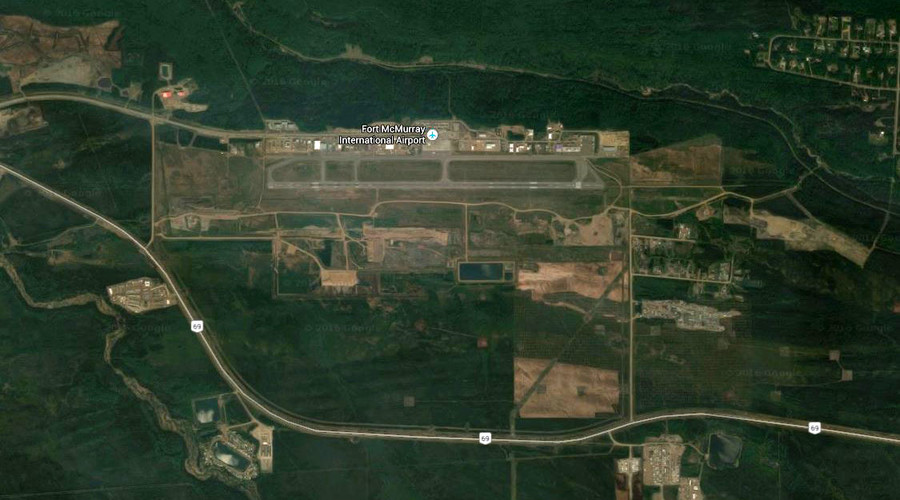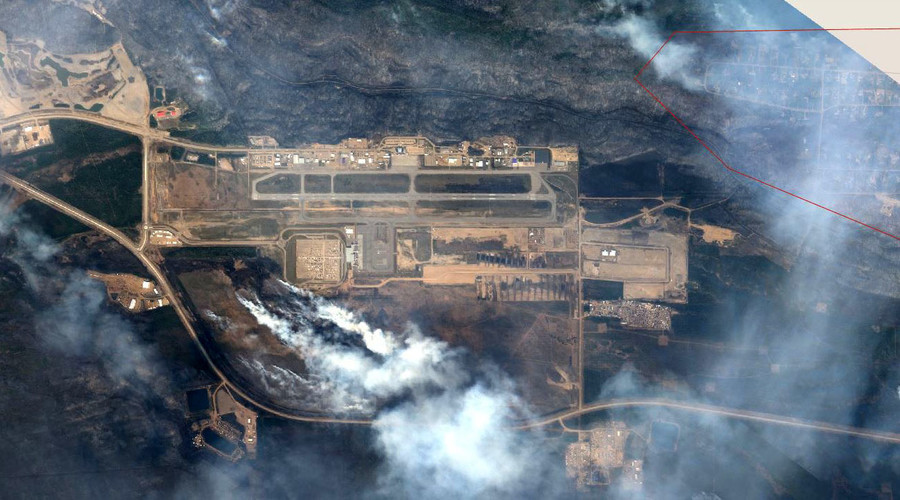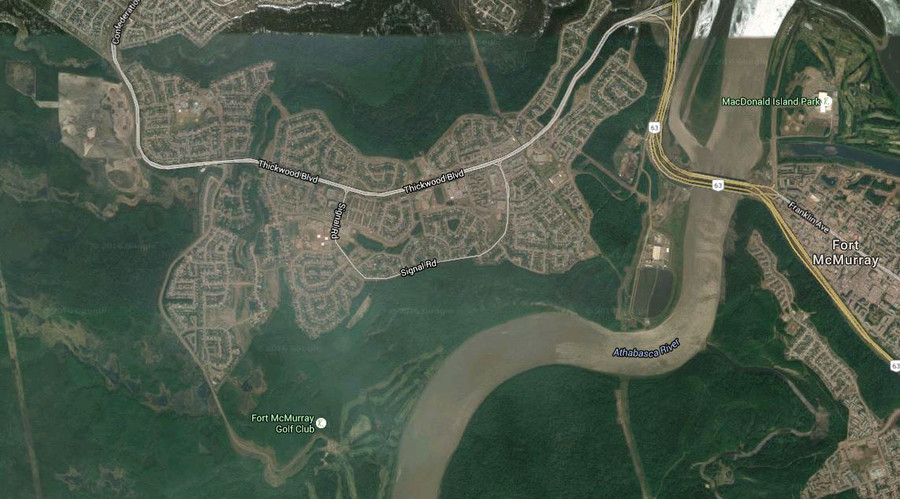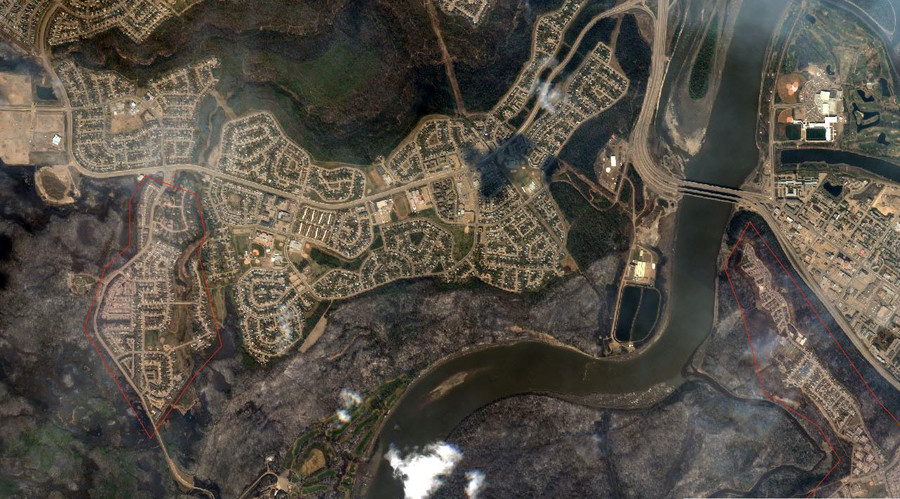
Earlier today, Canada's Globe and Mail released the following helicopter flyover showing the extent of Fort McMurray destruction in the heart of Canada's oilsands region, in the aftermath of the massive wildfire which continues to spread in Canada's Alberta province and until earlier today was threatening to enter neighboring Saskatchewan province.
Additionally, courtesy of the Google Crisis Response project, the following satellite images show the impact the wildfires have had on the area, as seen before and after the inferno. The residential estates of Fort McMurray, Beacon North Hill and Lower Townsite are no longer surrounded by thick greenery, as the fires left a ring of smoking, charred woods around the communities.
Beacon Hill North Before
After

Fort McMurray International Airport Before

After

Fort McMurray Golf Club Before

After

One question that has emerged is what initially started the fire: earlier today Alberta wildfire official Chad Morrison told a news conference that the likely cause of fire was human, in which case one wonders if there was specific intent and/or an interest to push the price of oil higher as a result of key infrastructure going offline for an indefinite period of time.
Whatever caused the initial spark, however, is for now irrelevant as the fire has now left the epicenter and has spread toward the main oil-sands facilities north of Fort McMurray, knocking out an estimated 1 million barrels of production from Canada’s energy hub.
* * *
There was some good news: a cold front scheduled to pass through the area Sunday may bring light rain that would help fire fighters battle the inferno. According to Bloomberg, the blaze, which was forecast to expand to more than 2,500 square kilometers (965 square miles) in the next few days, grew slower than expected and now covers about 1,600 square kilometers, Alberta Premier Rachel Notley said at a news conference on Sunday. While the fire approached a Suncor Energy Inc. site, there was no damage as firefighters are holding the blaze southwest of the area.
A cold front may bring a “bit of rain,” but will be preceded by winds of up to 60 kilometers an hour (37 miles an hour), spreading the fire further, Travis Fairweather, a forestry spokesman, said earlier. While cooler temperatures present responders with a "great opportunity" over the next three to four days, fires deep into the forest will likely last for months, Morrison said. The blazes are being blown east and are 30 to 40 kilometers (19 to 25 miles) from the border with Saskatchewan, Morrison said. The fire that began a week ago probably had a human cause, though that remains unknown, he said.
As Reuters adds, Canadian officials on Sunday showed some optimism for the first time that they were beginning to get on top of the country's biggest wildfire, as cooler weather and light rain stopped the blaze from growing as much as feared and winds took the flames away from oil sands boomtown Fort McMurray.
"It definitely is a positive point for us, for sure," said Alberta fire official Chad Morrison in a news briefing, when asked if the fight to contain the flames had a reached a turning point.
"We're obviously very happy that we've held the fire better than expected," said Morrison. "This is great firefighting weather, we can really get in here and get a handle on this fire, and really get a death grip on it."
As reported yesterday, the wildfire had been expected to double in size on Sunday, threatening the neighboring province of Saskatchewan, as it moved into its seventh day. But favorable weather helped hold it back, giving officials hope that they can soon begin assessing the damage to Fort McMurray, close to where the fire started, causing its 88,000 inhabitants to flee.
"As more and more fire has burned out around the city and the fuel around the city starts to disappear... we are starting to move into that second phase of securing the site and assessing the site," said Alberta Premier Rachel Notley, during the same media briefing.
Officials said it was too early to put a timeline on getting people back into the town safely.
The broader wildfire, moving southeast through wooded areas away from the town, would still take a long time to "clean up," Morrison cautioned. Officials had previously warned that the fire could burn for months. An Alberta government statement issued on Saturday night said the fire had consumed 200,000 hectares (500,000 acres) - an area the size of Mexico City - and would continue to grow.
In terms of pure monetary damages, the inferno was set to become the costliest natural disaster in Canada's history. One analyst cited by Reuters estimated insurance losses could exceed C$9 billion ($7 billion).
Officials said on Sunday the fire had done minor damage at CNOOC unit Nexen's Long Lake facility, in the site's yard. It was the first reported damage to an energy industry asset since the crisis began. Morrison said the fire was southwest of a Suncor Energy Inc facility, which Suncor identified as its base oil sands mining site north of Fort McMurray, and also near an unidentified Syncrude facility.
Estimates for offline production had been raised from 600mbpd to as much as 1 million barrels offline daily. It is still unclear how long until production is fully restored to prior capacity. The wildfires that may soon cover an area the size of Luxembourg have led to combined productions cuts of about 40 percent of the region’s output of 2.5 million barrels, based on IHS Energy estimates. The cuts, and the mass exodus of more than 80,000 people from Fort McMurray, represent another blow to an economy already mired in recession from the oil price collapse.
The best news, however, is that moments ago we got the first notice that things are indeed reverting back to normal: Suncor just announced in a statement, that it is beginning plan to restart oil-sands output shut by fire, adding that regional assets have been safe from fire, co. says in statement. Suncor had shut down operations in controlled manner to ‘facilitate a quick and reliable start-up. We expect most other producers to follow suit.